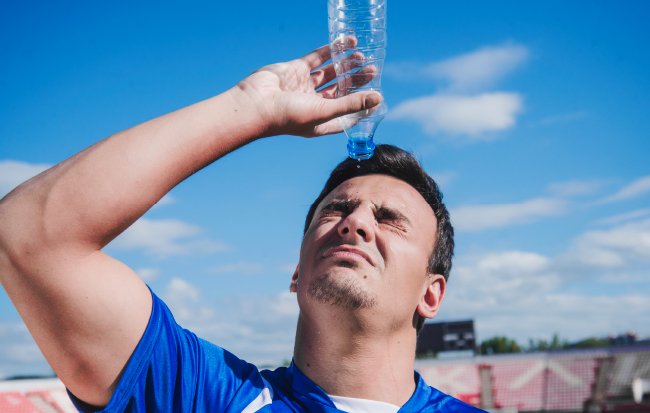Staying One Step Ahead
Dr Said Qabbaah
Medical Writer & Public Health Expert
As temperatures soar in Jordan and around the world and heatwaves become more common, the health risks associated with extreme heat are receiving increased attention. Among the most serious conditions linked to prolonged exposure are heat exhaustion and heat stroke.
Although both are preventable, they can lead to serious health complications if not managed properly. So, in order to enjoy your summer in the Kingdom, or wherever you may be, it is essential to watch out for the symptoms and know how to best avoid them.
Understanding Heat-Related Illnesses
The human body maintains a stable internal temperature, usually around 37°C, through a process called “thermoregulation” which is the body’s natural way of keeping its temperature within a healthy range, even as outside conditions change.
When external temperatures rise in Jordan, your body responds by sweating and increasing blood flow to the skin to overcome the heat.
However, prolonged exposure to high temperatures, especially when combined with high humidity, dehydration, or physical exertion, can overwhelm your body’s ability to cool itself down, resulting in heat-related illnesses.
These conditions occur in stages, beginning with mild symptoms, such as heat cramps progressing to more serious forms, such as heat exhaustion and heat stroke. The latter can impair vital organ functions and may even require urgent medical attention.
Heat Exhaustion: A Warning Sign
Heat exhaustion is a condition that results from excessive loss of water and salt, usually through sweating. If you are exposed to high temperatures, particularly during physical activity, be cautious.
Causes & Risk Factors
Several factors can increase the likelihood of heat exhaustion, including:
Hot and humid weather
Intense physical activity
Dehydration
Wearing excessive or non-breathable clothing
Alcohol consumption
Certain medications, such as diuretics and antihistamines
Age (young children and senior citizens are more susceptible)
Chronic illnesses, such as heart or kidney disease
Symptoms of Heat Exhaustion
Signs and symptoms of heat exhaustion are generally quite vague and may resemble those of other conditions, but common features to look out for include:
Heavy sweating
Weakness or fatigue
Dizziness or light-headedness
Headache
Nausea or vomiting
Muscle cramps
Cool, moist skin
Fast heartbeat
Low blood pressure when standing
These symptoms often develop gradually and may improve with rest, hydration and self-cooling. However, if not dealt with quickly or appropriately, heat exhaustion can progress to heat stroke.
Heat Stroke: A Medical Emergency
Heat stroke is the most serious form of heat-related illness and is considered a medical emergency. It happens when the body’s temperature regulation fails, causing the core body temperature to rise above 40°C.
Unlike heat exhaustion, heat stroke can cause direct damage to organs and tissues and may be life-threatening if not treated quickly.
Heat stroke may develop in two main ways:
- Exertional heat stroke: Normally affects younger, active individuals engaging in strenuous activity in hot conditions
2. Non-exertional (classic) heat stroke: More common in senior citizens, individuals with chronic illnesses, or those in poorly ventilated environments
While the risk factors are mostly the same as heat exhaustion, the signs and symptoms of a heat stroke tend to be different.
Symptoms of Heat Stroke
Heat stroke is accompanied by a significant rise in body temperature. Other symptoms may include:
Confusion or altered mental status
Slurred speech
Seizures
Hot and dry skin (though some people may continue to sweat)
Rapid breathing
Loss of consciousness
Absence of sweating despite heat exposure
Heat stroke is a medical emergency that requires immediate treatment to avoid organ damage or even death.
Diagnosis & Management
Quickly recognising the symptoms is critical to managing heat-related illnesses. If you suspect that you may be suffering from heat exhaustion, move to a cooler place and drink plenty of water.
You can add Himalayan salt to your water to restore your electrolyte balance and compensate for the salt you lost through sweating. Using cool cloths or taking a cool shower can also help bring your body temperature down.
If your symptoms do not improve, or if they worsen, you will need urgent medical attention. For heat stroke, emergency services should be contacted immediately. While waiting for help, use ice packs or spray cool mist on yourself, if you have it.
In severe cases, blood tests may be used to assess important parameters such as organ function and electrolyte levels.
Prevention Strategies
Here’s how you can prevent heat exhaustion and heat stroke whilst enjoying the weather in Jordan:
Staying hydrated by drinking water regularly, even if not thirsty, while avoiding alcohol and caffeine, which can contribute to dehydration
Dressing appropriately by wearing lightweight, breathable and light-coloured clothing
Limiting outdoor activity especially during the hottest parts of the day (usually between 12pm- 4pm)
When possible, using cooling methods such as fans, spending time in air-conditioned spaces, or taking cool showers
Allowing your body time to adjust gradually over several days if you’re working or exercising in a hot environment
Monitoring senior citizens by checking in on them, as well as infants and those with chronic illnesses during heatwaves
Being aware of the symptoms which can help prevent progression to a more serious illness
As heatwaves grow more intense in Jordan and globally, so do the health dangers they bring. Recognising the early signs of heat exhaustion and heat stroke could be the difference between a quick recovery and a life-threatening emergency. Staying one step ahead of the heat isn’t just smart, it could potentially save a life.
You can contact Dr Said Qabbaah at [email protected]






